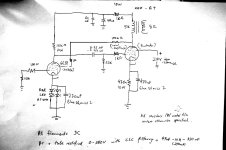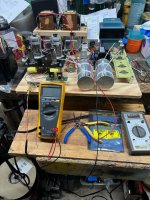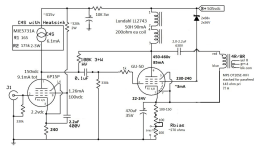Thanks,
I was using a 5K load-line and used two grid steps which is not exactly small signal. This makes sense that I got a lower number.
I was using a 5K load-line and used two grid steps which is not exactly small signal. This makes sense that I got a lower number.
Hey all. Much poking around the internets later, I've found several schematics and think I want to go with a 6E5P driver. Here's a design from @Wavebourn that ticks most of my boxes:

I'll probably build a power supply like the one in the Lacewood 2.0 amp

I have the Hammond 274BX on hand, but I'm not sure if it has enough muscle for this amp. The 278X is rated for 800vct @ 230mA. That would put my no-load voltage above 450v, pushing up costs across the amp. And those Triad C-24x chokes...the datasheet gives no upper voltage range for them, and I don't want to buy 500v-rated Hammonds at 4x the cost. But with the 274BX, given the high cathode voltage, losses to OPT, I'm limiting the output tubes to 360V@80mA or so... seems low. A proper analysis with PSUD2 would prob help here.
I'll probably build a power supply like the one in the Lacewood 2.0 amp
I have the Hammond 274BX on hand, but I'm not sure if it has enough muscle for this amp. The 278X is rated for 800vct @ 230mA. That would put my no-load voltage above 450v, pushing up costs across the amp. And those Triad C-24x chokes...the datasheet gives no upper voltage range for them, and I don't want to buy 500v-rated Hammonds at 4x the cost. But with the 274BX, given the high cathode voltage, losses to OPT, I'm limiting the output tubes to 360V@80mA or so... seems low. A proper analysis with PSUD2 would prob help here.
This amplifier would probably work better with pentodes in both the input and output positions, with Schade-style feedback directly from the plate of the GU-50 to the input pentode tube plate. For an input tube I'd like to suggest the 6AH6, a relatively high transconductance pentode. The plate current on the 6AH6 can be dialed down somewhat to reduce the transconductance of the input stage. I did something similar with my second version of the "Shrine" amplifier using a 6AH6 pentode front end and 6L6GC output finals. The GU50 can be treated as a 6L6GC with larger cojones (plums, stones boll**ks) that can be run at a higher bias current due to its higher plate dissipation rating of 40W, vs. the 30W rating for the 6L6GC. For guidance, I have referenced the second phase of my "Shrine" amplifier thread where I converted the original amplifier to use a pentode input and output stages, employing partial "Schade" feedback to reduce the output impedance of the final stage, emulating triode characteristics.
The second phase of the "Shrine" amplifier documenting its conversion to a partial "Schade-style" feedback is documented here - the second stage of the effort starts at around post #50.
https://www.diyaudio.com/community/threads/shrine-se-amp-using-6ah6-and-1625.93560/page-3
The second phase of the "Shrine" amplifier documenting its conversion to a partial "Schade-style" feedback is documented here - the second stage of the effort starts at around post #50.
https://www.diyaudio.com/community/threads/shrine-se-amp-using-6ah6-and-1625.93560/page-3
Last edited:
I have a breadboard started for a GU50 SE into a 5K output but using a CCS plate loaded 6P15P driver tube with plate to plate feedback for an all Russian tube set. I have a 6V6-6V6 amp along these lines and it sounds wonderful but only 3ish watts. Using a power tube as the driver has advantages since the plate-to-plate feedback lowers the impedance seen by the driver.
Using something rated as a power pentode at the input seems a sensible option to increase the drive capability. I got away with using a 6AH6 to drive the 6L6GC, but i also used a medium amount of bias current for the input pentode. I guess I'll find out how things fare when I actually try to extract some significant output power from the amp.
Well I already got 6P1P, 6P15P, 6P14P, and 6E5P. So I'm not gonna buy any more. Hehe. But I see this amp as a breadboard project (in a nice chassis) that I can use to learn more about how these thingies work. Does Pentode sound different than all 3 grids wired Triode? Probably. Can I build an amp that can demonstrate that?
Me too. I am planning to experiment with screen drive for my GU 50 amp.I have been wanting to build a P-P amp with GU50's. maybe 2-4 tubes per amp
While I think about it, I tried a GU50 in se triode mode. The first one (tube) was very reluctant and I decided it was gassy, and tried another. That one was much happier and quite frisky. (Wanted to oscillate). Put the gassy one in tube tester and ran it hot for a while and the gassyness subsided and it seemed cured. YMMV. I didn't think much of it as a triode in my application, el34 sounded much sweeter, but ended up with the cheap Russia pseudo 6L6. Not as.much power though.
Very nice. Is that a Gyrator loading the driver tube? And zeners dropping the g2 voltage in the power tube?
It would be interesting to try a depletion mode MOSFET for the current source load. The Ixys/Littelfuse IXTP01N100D would be a good start. It has relatively low capacitance, so it might preserve a semblance of linearity out to a higher frequency.
Oh, and how did you persuade Musical Power Supplies to do a 20W transformer with an ungapped stack - their H-Fi offerings only list a 10W capability.
Oh, and how did you persuade Musical Power Supplies to do a 20W transformer with an ungapped stack - their H-Fi offerings only list a 10W capability.
Last edited:
I just asked. I had already purchased some 10W hifi outputs and he was willing to make a 20W rated hifi SE transformer for me. The stacking is just a choice given that he has a bobbin winding plan for it.Oh, and how did you persuade Musical Power Supplies to do a 20W transformer with an ungapped stack - their H-Fi offerings only list a 10W capability.
@nerdorama thank you for your photos and impressions.
How does it sound?
Is the screen supply fine with no resistor as screen stopper / current limiter?
What is the wattage of the zeners?
I've seen you have no resistoras to ground to ensure a minimum current through the zeners. Is it fine as well?
How does it sound?
Is the screen supply fine with no resistor as screen stopper / current limiter?
What is the wattage of the zeners?
I've seen you have no resistoras to ground to ensure a minimum current through the zeners. Is it fine as well?
I had screen bypass caps but blew up a set of zeners and got a recommendation to remove them. I installed a new set with a 10 ohm series resistor and no bypass caps. I listened to the amp for a couple of hours last night but ready to report on sonics yet. Will try to get some measurements this weekend. I measure only 2 mA into the combined screens of both tubes and the screen voltage is at 230v. More to come.
I am considering using a mosfet with the zeners driving the gate for the screens as I have seen done here by others.
I am considering using a mosfet with the zeners driving the gate for the screens as I have seen done here by others.
- Home
- Amplifiers
- Tubes / Valves
- GU-50 with 5k SE OPTs? Thinking about a new amp


